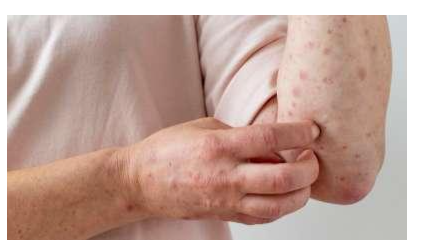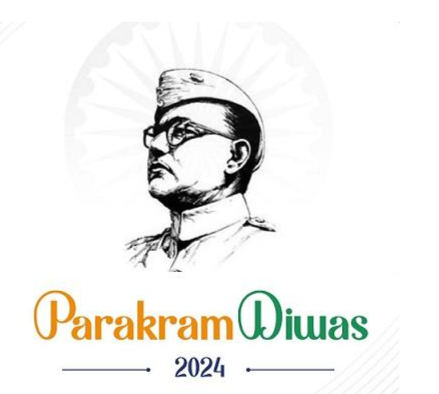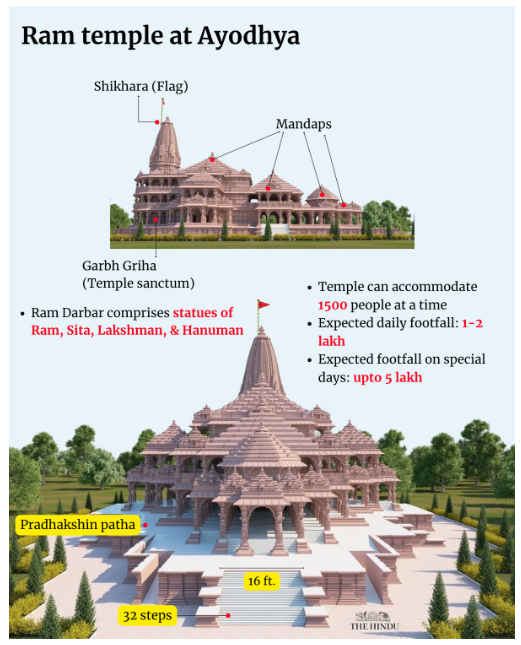Monday, 29th January 2024
Indo-France Bilateral Relations
In News: Emmanuel Macron, the President of France, graced India as the Chief Guest during the commemoration of the 75th Republic Day.
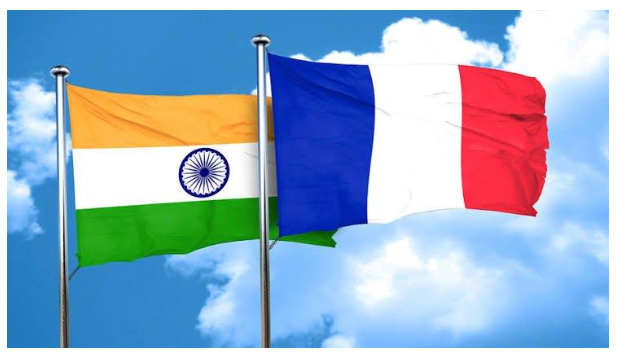
Indo-France Bilateral Relations: A 75-Year Legacy
Establishment and Evolution of Diplomatic Ties
- India and France forged diplomatic relations in 1948, marking a rich history of 75 years of close and friendly interactions.
- The journey culminated in the elevation of their diplomatic relationship to a Strategic Partnership in 1998, celebrating its 25th anniversary in January 2023.
Key Pillars of India-France Cooperation
- Defence Cooperation: A Solid Foundation
- The 2006 Agreement on Defence Cooperation, renewed in 2016, serves as the cornerstone for all defence activities between India and France.
- Notably, the opening of a DRDO office in the Embassy in 2023 strengthens technology cooperation, exemplified by the procurement of Rafale jets, enhancing India's air power.
- Space Cooperation: Bridging the Skies
- ISRO and the French Space Agency, CNES, collaborate on joint research programs and satellite launches.
- A significant milestone was the successful launch of the GSAT-24 communication satellite from Kourou, French Guiana, aboard Ariane-5 on June 22, 2022.
- Civil Nuclear Cooperation: Nurturing Energy Partnerships
- The 2008 agreement on civil nuclear cooperation led to France's involvement in the Jaitapur Nuclear Power Project.
- Although progress has been gradual since the initial pact in 2008, both nations aim to establish partnerships in Small Modular Reactors (SMR) and Advanced Modular Reactors (AMR).
- Economic Cooperation: A Thriving Partnership
- Bilateral investments and trade cooperation thrive in sectors such as IT corridors, smart cities, railways, capital and trade exchanges, and skill development.
- Notably, bilateral trade reached $13.4 billion in 2022-23, showcasing a substantial 7.72% increase from the previous year.
- France emerges as the 11th largest investor in India, with an FDI inflow of $10.5 billion from April 2000 to March 2023.
- Digital Cooperation: Pioneering Cybersecurity Initiatives
- The India-France Roadmap on Cybersecurity and Digital Technologies, a product of the 2019 visit of the Indian PM to France, has laid the foundation for significant collaborations.
- In July 2023, the Unified Payments Interface (UPI) was launched from the Eiffel Tower, facilitating secure and convenient transactions for Indian visitors and NRIs.
- Culture and Tourism Cooperation: A Tapestry of Shared Heritage
- Numerous Indo-French cultural associations organize events across France, exemplified by the 'Namaste France' cultural festival organized by the Government of India in 2016.
- Marine and Maritime Cooperation: Charting Blue Horizons
- Indo-French Maritime Cooperation is guided by the India-France Roadmap on Blue Economy and Ocean Governance adopted in 2022.
- Community in France: A Cultural Tapestry
- The Indian community, numbering around 109,000, including NRIs, is predominantly from French enclaves like Puducherry, Karaikal, Yanam, Mahe, and Chandernagore, contributing to the cultural diversity in mainland France.
Key Outcomes of the Visit: Paving the Way for Collaboration
- Roadmap for India-France Defence Industrial Partnership
- The primary objective of this strategic roadmap is to identify collaborative opportunities in the development and production of military equipment.
- It encompasses joint efforts in designing, developing, and manufacturing military assets, as well as establishing robust supply chains for defence goods.
- The focus extends to cutting-edge technologies, embracing robotics, artificial intelligence (AI), autonomous vehicles, platforms, and cyber defence.
- This comprehensive roadmap spans air and space technologies, as well as maritime technology, with a specific emphasis on underwater domain awareness.
- Defence-Space Partnership: Enhancing Situational Awareness
- The signing of a new agreement solidifies the commitment to a defence-space partnership, emphasizing collaboration on space situational awareness.
- This marks a significant step in aligning efforts in the realm of space exploration.
- Airbus-TATA Chopper Deal: Strengthening Defence Collaboration
- Tata and Airbus Helicopters have forged an industrial partnership for the production of H125 helicopters, fostering deeper collaboration in the defence sector.
- Mega Defence Deals in the Pipeline
- Two substantial multi-billion-dollar defence deals are currently undergoing cost negotiations between India and France.
- These include the procurement of 26 Rafale-M fighter jets for the Indian Navy’s aircraft carriers and the acquisition of three additional Scorpene-class conventional submarines.
- Cooperation in Satellite Launches: Advancing Space Initiatives
- A Memorandum of Understanding (MoU) between New Space India Ltd and France's Arianespace signifies a commitment to collaborate on satellite launches and further space exploration initiatives.
- Introduction of the Young Professional Scheme: Facilitating Exchange
- This scheme facilitates the exchange of individuals aged 18-35 and extends visa validity to five years for Schengen visas for Indian students pursuing master's degrees in France.
Key Announcements Made During the Visit: Shaping the Future
- Year 2026 as the India France Year of Innovation
- A joint declaration designates the year 2026 as the India-France Year of Innovation, showcasing a commitment to fostering innovative collaborations.
- Operationalization of UPI at Eiffel Tower
- A significant announcement includes the operationalization of the Unified Payments Interface (UPI) at the iconic Eiffel Tower, providing secure and convenient transactions for visitors.
- Setting up of a Solar Academy in Senegal under STAR-C Program
- Under the STAR-C program of the International Solar Alliance (ISA), a Solar Academy will be established in Senegal.
- This initiative, in partnership with the United Nations Industrial Development Organisation (UNIDO), aims to boost solar power ecosystems in the poorest countries.
- Establishment of India’s Consulate in Marseille and French Bureau de France in Hyderabad
- Both nations have agreed to establish India’s Consulate in Marseille and a French Bureau de France in Hyderabad, strengthening diplomatic ties and facilitating enhanced collaboration.
Source: IT
Demand for Advanced Driver Assistance Systems
In News: As autonomous driving gains traction worldwide, India is emerging as an unexpected yet crucial market, experiencing a notable increase in demand for Advanced Driver Assistance Systems (ADAS).
Advanced Driver Assistance Systems (ADAS): A Comprehensive Overview
Definition: Transforming Driving Experiences
Advanced Driver Assistance Systems (ADAS) refer to in-vehicle digital technologies designed to aid drivers in routine navigation and parking. Unlike fully automated systems, ADAS leverages computer networks to enhance driving experiences through data-driven assistance, prioritizing safety.
Components: Sensors, Cameras, and Radar for Environmental Monitoring
ADAS systems utilize an array of sensors, cameras, and radar to actively monitor the vehicle's surroundings. This technology provides real-time information, driving interventions, and assistance with parking.
Objectives: Enhancing Safety and Preventing Accidents
The primary goal of ADAS is to reduce the frequency and severity of automotive accidents, aiming to prevent deaths and injuries. These systems offer vital data on traffic conditions, road closures, congestion levels, and recommended routes to avoid delays.
Popular ADAS Features: Elevating Safety Standards
The ADAS suite encompasses various features, including automatic emergency braking, forward collision warning, blind spot collision warning, lane-keeping assist, adaptive cruise control, and more.
Reasons for Surge in Demand in India: Driving Forces
- Progressive Democratisation: Making ADAS Accessible
- India is experiencing a democratization of autonomous driving tools, with car manufacturers increasingly offering ADAS as standard features in mid-segment vehicles.
- This contributes to the growing demand for advanced driver assistance technology.
- Road Safety Concerns: Prioritizing Safety Features
- Despite challenging road conditions, there is a heightened emphasis on road safety in India.
- Car manufacturers integrate ADAS features to enhance safety and provide consumers with advanced driving assistance tools.
Challenges in India for ADAS Systems: Navigating Roadblocks
- Road Infrastructure Challenges: A Diverse Terrain
- India's varied driving environment, from well-maintained highways to poorly constructed rural roads, presents challenges for ADAS systems to consistently interpret road markings and infrastructure.
- Diverse Road Users: Addressing Complexity
- Indian roads host a mix of pedestrians, cyclists, and non-motorized vehicles alongside motor vehicles, adding complexity to ADAS adaptation.
- Consideration for non-motorized road users is crucial, as highlighted by a study from the World Resources Institute (WRI) India.
- Connectivity and Data: Ensuring Real-Time Updates
- ADAS systems rely on real-time data updates and reliable connectivity.
- Issues may arise in remote or poorly networked areas of India, posing challenges for seamless operation.
- Vulnerable to Hacking: Cybersecurity Concerns
- A major concern regarding ADAS systems is their vulnerability to cyberattacks.
- The potential for hacked vehicles raises safety concerns and underscores the need for robust cybersecurity measures.
- Driver Behaviour: Educating and Raising Awareness
- The success of ADAS systems hinges on responsible driving behavior.
- A survey by the Institute of Road Traffic Education (IRTE) revealed that only 44% of drivers in India were aware of ADAS technology, emphasizing the necessity for widespread education on its benefits and usage.
|
UPSC Previous Year Questions Prelims (2020) Q. With the present state of development, Artificial Intelligence can effectively do which of the following?
Select the correct answer using the code given below: (a) 1, 2, 3 and 5 only Ans: (b) |
Source: IE
India's Geographical Indication Landscape
In News: The journey of India's Geographical Indication (GI) tags spanning over two decades encounters challenges, as the limited outcomes underscore the necessity for reforms in the registration processes.
Geographical Indication (GI): A Defining Marker for Origin-based Products
Definition: Linking Quality to Geographic Origin
- A Geographical Indication (GI) is a designation assigned to products originating from a specific geographical area, signifying that the inherent qualities or reputation of the products are closely tied to that particular origin.
Legal Framework and Governance: Upholding Standards
- GI is regulated under the Agreement on Trade-Related Aspects of Intellectual Property Rights (TRIPS) at the World Trade Organization (WTO).
- In India, the Geographical Indications of Goods (Registration and Protection) Act, 1999 aims to register and protect geographical indications related to goods.
Categories in EU and India: PGI and PDO
- While many EU nations classify GI into Protected GI (PGI) and Protected Destination of Origin (PDO), India currently adopts only the PGI category.
- This certification extends beyond agricultural products to include non-agricultural items, like handicrafts, rooted in the unique skills and resources of specific regions.
GI as a Socio-Economic Catalyst: Empowering Communities
- GI serves as a robust tool for safeguarding traditional knowledge and culture, fostering socio-economic development in the regions associated with the certified products.
Status of GI Tags Registration: A Global Perspective
- Global Landscape: Registration Statistics
- India faces a lag in GI registration compared to other nations. As of December 2023, only 547 out of 1,167 applications have been registered. Globally, Germany leads with 15,566 registered products, followed by China with 7,247, according to 2020 data from the World Intellectual Property Organization.
- Composition of Registered GIs: A Global and Indian View
- Globally, wines and spirits make up 51.8% of registered GIs, followed by agricultural products and foodstuffs at 29.9%. In India, handicrafts constitute approximately 45%, while agriculture comprises about 30% of GI products.
Concerns Regarding the GI Tags in India: Addressing Challenges
- Challenges with GI Act and Registration Process: Modernization Imperative
- The GI Act of 1999 requires timely amendments to meet current challenges. Simplifying registration forms and application processing times is crucial for increased compliance.
- Ambiguity in Producers' Definition: Streamlining Benefits
- Lack of clarity in defining "producers" leads to intermediaries benefiting from GIs, diluting advantages for genuine producers.
- Disputes at the International Level: Highlighting Attention Gaps
- International disputes, as seen with products like Darjeeling tea and Basmati rice, underscore that GIs receive less attention compared to patents, trademarks, and copyrights.
- Academic Attention: Encouraging Scholarly Focus
- Limited academic focus on GIs is evident in India. Efforts are needed to bolster academic interest and research in this field.
Strategies to Realize the Potential of GI-based Products: Unlocking Opportunities
- Incentivizing Producers: Grassroots Boost
- Government initiatives should incentivize producers at the grassroots level to stimulate growth in GI numbers.
- Defining "Non-Producers": Ensuring Direct Benefits
- Laws should exclude "non-producers" from benefiting, ensuring direct advantages for genuine producers.
- Technology and Skill-building: Modernizing Stakeholders
- Technological advancements, skill-building, and digital literacy are crucial for the modernization of GI stakeholders.
- Global Promotion: Leveraging Diplomatic Channels
- Indian embassies should actively promote GI-based products to encourage growth in the foreign market.
- International Collaboration: Boosting Global Presence
- Favorable international tariff regimes and special attention to GI products at WTO can enhance their global presence.
- Integration with One District One Product Scheme: Amplifying Reach
- Aligning GIs with the One District One Product scheme can enhance promotion and market reach.
- Rural Market Visibility: Boosting Presence in Gramin Haats
- Developing market outlet schemes, especially in rural markets (gramin haats), can amplify the visibility of GI products.
- Quality Assurance: Establishing Testing Laboratories
- Establishing testing laboratories at marketplaces is essential to ensure consumer faith in the quality of GI products.
- Startups and SDGs: Aligning for Social Development
- Aligning startups with GIs and linking their performance with Sustainable Development Goals (SDGs) can contribute to social development.
|
UPSC Previous Year Questions Prelims (2015) Q Which of the following has/have been accorded ‘Geographical Indication’ status?
Select the correct answer using the code given below: (a) 1 only Ans: (c) Prelims (2018) Q. India enacted the Geographical Indications of Goods (Registration and Protection) Act, 1999 in order to comply with the obligations to (2018) (a) ILO Ans: (d) Mains (2019) Q. How is the Government of India protecting traditional knowledge of medicine from patenting by pharmaceutical companies? |
Source: DTE
VAIBHAV Fellowship
In News: The Department of Science and Technology (DST) has recently introduced the inaugural group of fellows as part of the Vaishvik Bhartiya Vaigyanik (VAIBHAV) scheme.
VAIBHAV Scheme: Connecting Indian STEMM Diaspora for Collaborative Research
- Overview of VAIBHAV Scheme
- The VAIBHAV fellowships programme, initiated in 2023 by the Government, aims to establish connections between the Indian STEMM (Science, technology, engineering, mathematics, and medicine) diaspora and Indian academic and R&D institutions.
- The primary goal is to facilitate collaborative research, leading to the exchange of knowledge, wisdom, and best practices in the forefront of science and technology.
- Implementation and Key Features
- VAIBHAV Fellows:
- Individuals engaged in research activities of Indian origin (Non-resident Indians, Persons of Indian Origin, Overseas Citizen of India) are eligible for the fellowships.
- Collaborative Research:
- The VAIBHAV Fellow identifies an Indian institution for collaboration and may spend up to two months per year, with a maximum duration of three years.
- Collaboration focuses on cutting-edge areas of Science and Technology.
- VAIBHAV Fellows:
- Incentives Offered
- Fellowship Grant: INR 4,00,000 per month.
- Travel: Support for international and domestic travel.
- Accommodation: Accommodation expenses covered.
- Contingencies: Additional support for contingencies.
- Research Grants: Host institutions receive research grants to support collaboration.
- Significance of Vaibhav Scheme
- Strengthens Global Collaboration: Enhances global collaboration in scientific research.
- Knowledge Exchange: Facilitates the exchange of knowledge and expertise in Indian academic and research institutions.
- Implementation Authority
- Implemented by the Department of Science and Technology (DST), Ministry of Science and Technology.
Visiting Advanced Joint Research Faculty Scheme (VAJRA): Promoting Collaborative Research
- Overview of VAJRA Scheme*
- The VAJRA Faculty Scheme is an exclusive program for overseas scientists and academicians, with a focus on NRI and PIO/OCI, to serve as adjunct/visiting faculty in Indian public funded academic and research institutions.
- The scheme emphasizes collaborative research, information sharing, and the translation of science into practice.
- Implementation and Key Features
- Eligibility: Open to overseas scientists and academicians, including NRI, PIO, and OCI.
- Research Areas: The research undertaken by the faculty should be of interest to India, including the translation of science into practice.
- Duration: Faculty works for a minimum of 1 month and a maximum of 3 months per year in an Indian institution, with the possibility of extension.
- Part-time Position: The part-time faculty position is initially offered for 1 year and can be renewed annually.
- Incentives Offered
- Honorarium: USD 15000 for the first month and USD 10000 per month for the next two months to cover travel and honorarium.
- Additional Support: Host institutions may consider providing additional support, though no separate support is mandated.
- Implementation Authority
- Implemented by the Science and Engineering Research Board (SERB), a statutory body of the Department of Science and Technology.
- SERB Objectives: Promoting basic research in science and engineering, providing financial assistance to researchers, academic institutions, and other agencies.
Source: TH
PM CARES Fund
In News: The Delhi High Court overturned a Central Information Commission (CIC) directive instructing the Income Tax department to disclose information about tax exemptions granted to the PM Cares Fund under the Right to Information Act, 2005.

About PM CARES Fund: Responding to Emergencies
- Creation and Purpose
- Established on March 28, 2020, in response to the COVID-19 pandemic in India.
- Dedicated national fund to address emergencies and provide relief to those in distress.
- Fund Constitution
- Registered as a Public Charitable Trust.
- The Prime Minister serves as the ex-officio Chairman, with the Ministers of Defence, Home Affairs, and Finance as ex-officio Trustees.
- The Chairperson (Prime Minister) has the authority to nominate three eminent persons to the Board of Trustees from various fields.
- Objectives
- Undertake and support relief efforts related to public health emergencies, as well as other emergencies, calamities, or distress, whether man-made or natural.
- Provide financial assistance, grants, or payments for the affected population.
- Engage in activities consistent with the stated objectives.
- Fund Finance
- Comprises solely of voluntary contributions from individuals and organizations, without any budgetary support.
- Donations to PM CARES Fund qualify for 80G benefits, ensuring 100% exemption under the Income Tax Act, 1961.
- Eligible as Corporate Social Responsibility (CSR) expenditure under the Companies Act, 2013.
- Exempted under the Foreign Contribution Regulation Act (FCRA), with a dedicated account for receiving foreign donations, enabling contributions from individuals and organizations in foreign countries.
Source: LL
The International Court of Justice
In News: The International Court of Justice has recently decided not to dismiss the genocide case against Israel.
International Court of Justice (ICJ): Key Facts
- Establishment and Location
- The ICJ, also known as the World Court, is the primary judicial organ of the United Nations (UN).
- Established in June 1945 by the UN Charter, it commenced operations in April 1946.
- Headquartered at the Peace Palace in The Hague, Netherlands, making it the only UN principal organ not situated in New York, United States.
- Operational Details
- Hearings of the ICJ are always conducted in public.
- Official Languages: French and English.
- Powers and Functions
- The ICJ handles two types of cases: "contentious cases" between member States and advisory opinions sought by UN bodies or specialized agencies.
- Contentious case disputes cover various areas such as land frontiers, maritime boundaries, territorial sovereignty, non-use of force, violation of international humanitarian law, non-interference in internal affairs, and diplomatic relations.
- Judgments in contentious cases are final and binding on involved parties, while advisory opinions are non-binding.
- Decisions are based on international law, including conventions, custom, general principles, judicial decisions, and expert writings.
- Composition
- Consists of 15 judges, each from a different country, elected to nine-year terms by majority votes in the UN General Assembly and the Security Council.
- Judges, elected one-third every three years, are eligible for reelection.
- Judges act independently, representing neither their own government nor any other State.
- The ICJ Statute allows a state party to a case without a judge of its nationality on the bench to appoint a judge ad hoc for that specific case.
- Administration
- Assisted by a Registry, its permanent administrative secretariat, which operates independently of the United Nations Secretariat.
Source: HT
Free Movement Regime
In News: The Home Minister has recently stated that the reconsideration of the Free Movement Regime (FMR) agreement with Myanmar is under consideration.
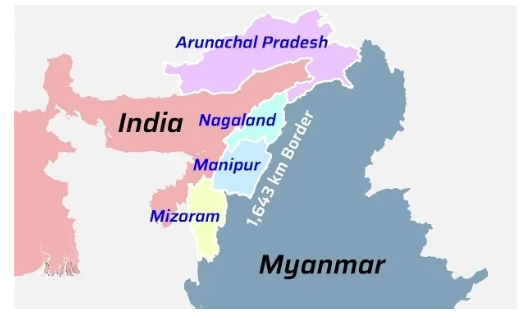
Free Movement Regime (FMR): Facilitating Cross-Border Interaction
- Overview of FMR
- The Free Movement Regime (FMR) allows all hill tribes, regardless of Indian or Myanmar citizenship, to travel within 16 km on either side of the Indo-Myanmar Border (IMB).
- Cross-border travel requires a border pass, valid for one year, issued by the competent authority, allowing a stay of up to two weeks per visit.
- Implemented in 2018 under the Central government's Act East policy.
- Jointly administered by both the Indian and Myanmar governments for people residing along the IMB.
- Benefits of FMR
- Cultural Integration: FMR facilitates cultural assimilation among trans-border villages through events like weddings, shared festivals, and cross-border trade.
- Reflects Linkages: Demonstrates the physical, ethnic, linguistic, cultural, and fraternal connections among trans-border villagers.
Key Facts about Indo-Myanmar Border (IMB)
- Extent: The IMB spans 1,643 km across the states of Mizoram, Manipur, Nagaland, and Arunachal Pradesh.
- Geographic Range: It stretches from the northern tripoint with China to the southern tripoint with Bangladesh.
- Security: Assam Rifles is entrusted with guarding the IMB.
Source: TH
Futala Lake
In News: The Supreme Court has recently directed the Maharashtra government and its metro rail corporation to refrain from conducting any construction activities at the renowned Futala Lake in Nagpur.
About Futala Lake: A Historical Marvel
- Location and Name
- Futala Lake, also recognized as Telankhedi Lake, is situated in the western part of Nagpur, Maharashtra.
- Historical Significance
- With a history spanning more than 200 years, the lake is believed to have been built by the Bhonsle kings of Nagpur.
- Geographical Details
- The lake spans an expansive area of 60 acres.
- Architectural Features
- Constructed by the Bhonsle rulers, Futala Lake is renowned for its vibrant fountains.
- Scenic Surroundings
- The lake is enveloped by forests on three sides, complemented by a landscaped beach on the fourth side.
Key Facts about Bhonsle Dynasty: Legacy of Maratha Rulers
- Founding and Leadership
- The Bhonsle or Bhonsale Maratha clan was established by Raghuji Bhonsle of Berar in 1730.
- Prominent Figure
- Shivaji, the founder of the Maratha empire, was a notable member of the Bhonsle clan.
- Succession and Rule
- The dynasty's successors, serving as maharajas from Satara, saw the transition of "de facto" rule to the Peshwas during Shahu I's reign.
- Expansion Across States
- Besides ruling from Satara, Bhonsle Maharajas established their influence in Thanjavur (17th century), Nagpur, and Kolhapur (18th century).
- Post-Maratha War Era
- Following the Marathas' defeat in the Third Anglo-Maratha War in 1818, the Bhonsle states acknowledged British rule while retaining local autonomy.
- British Rule and Continuation
- The Bhonsle dynasties continued as rulers of their princely states, with Nagpur, Thanjavur, and Satara eventually coming under direct British rule in the mid-19th century.
- Legacy and Independence
- Kolhapur persisted as a princely state until India's independence in 1947, when the rulers acceded to the Indian government.
Source: DH
Tasar Silk
In News: In the Republic Day parade held recently, Jharkhand's tableau highlighted the expertise of tribal women in the crafting of Tasar silk.

About Tasar Silk: The Elegance of Wild Silk
- Origin and Silk Production
- Tasar Silk is a type of wild silk derived from silkworms that feed on plants like Asan and Arjun.
- Known by various names across India, including tusaar, tusser, tushar, tusa, tassore, and tasar.
- Global and Indian Production
- Globally produced in countries like China, Sri Lanka, and Bangladesh.
- India holds the distinction of being the second-largest producer of tussar silk and the exclusive producer of Indian tussar, primarily tended to by tribal communities.
- Major production regions in India include Madhya Pradesh, Jharkhand, and Chhattisgarh, with Jharkhand emerging as one of the largest producers.
- Distinctive Features
- Natural Golden Color: Valued for its natural golden hue, Tasar Silk is also found in shades of brown, cream, and orange, attributed to carotenoids in the silk.
- Unique Texture: Characterized by a distinctive 'rough' or 'crinkly' texture due to shorter fibers compared to other silks.
- Checkerboard Pattern Weave: Tasar silk fabrics feature a unique weave with thicker threads, creating a 'checkerboard' pattern.
- Properties and Wearability
- Strength and Softness: Despite its lightweight nature, Tasar silk is surprisingly strong, offering a luxurious soft feel akin to cashmere or velvet.
- Moisture Management: Does not retain moisture, making it comfortable to wear in warmer climates.
- Porous Quality: More porous nature enhances its wearability.
Source: PTI
Singchung Bugun Village Community Reserve
In News: During the Republic Day parade, Arunachal Pradesh highlighted its Singchung Bugun Village Community Reserve, a 17-square-kilometer biodiversity hotspot.
Singchung Bugun Village Community Reserve: Safeguarding Biodiversity
- Location and Size
- Situated in Arunachal Pradesh, the Singchung Bugun Village Community Reserve spans 17 square kilometers.
- Located approximately 40 km from the renowned Eaglenest Wildlife Sanctuary.
- Establishment and Purpose
- Established in 2017, the reserve aims to preserve the biodiversity of the region.
- Unique Species and Endangered Wildlife
- Habitat for Critically Endangered Species: The reserve is a habitat for the Bugun Liocichla (Liocichla bugunorum), a passerine bird named after the Buguns community.
- Significance: This bird species was among the first to be discovered in India post-independence in 1947 and is exclusively found on Buguns' community lands.
- Buguns Community
- Indigenous Population: The Buguns community, with a population of around 2,000 people, resides in 12 villages located outside the forests of the Eaglenest Wildlife Sanctuary.
- Custodians of the Reserve: The Buguns play a vital role in the conservation efforts, contributing to the protection of this unique biodiversity hotspot..
Source: PTI
ICJ Proceedings: South Africa vs. Israel
In News: A recent delves into the Genocide Convention and the ongoing 'South Africa vs Israel Case' at the International Court of Justice (ICJ).
Genocide Convention
- About:
- The Genocide Convention codified the crime of genocide in international law.
- Adopted by the UN General Assembly on December 9, 1948.
- Reflects the commitment to 'never again' after the atrocities of World War II.
- A pivotal step in the development of international human rights and criminal law.
- Features:
- Genocide is a crime applicable in both war and peace, as per the Convention.
- The Convention's definition is widely adopted at national and international levels.
- Establishes the obligation on State Parties to prevent and punish genocide.
- Considered as norms of international customary law, binding on all states.
'South Africa vs Israel Case' at ICJ
- South Africa’s Allegations:
- Accusations include killing Palestinians, destruction of homes, expulsion, and displacement by Israeli forces.
- Involves a blockade on essential supplies and measures preventing Palestinian births.
- South Africa’s Demands:
- Urgent ICJ intervention through "provisional measures" to prevent further crimes.
- Argues the need for measures to protect the rights of Palestinians violated under the Genocide Convention.
- Israel’s Stand:
- Israel rejects allegations, defending its actions as self-defense under international humanitarian law.
- Views the case as "preposterous" and denies committing genocide.
- International Community's Stand:
- Several countries and organizations support South Africa's suit.
- The US supports Israel, claiming allegations of genocide are unfounded.
- The UK and France oppose the case.
Different Concerns in the Case:
- ICJ as One Forum:
- Questions about focusing on Israel while non-state actors like Hamas can't be brought to the ICJ.
- The ICC deals with individuals, and the situation has been referred for investigation.
- Global Split:
- Divide among nations, reflecting historical power dynamics.
- Bangladesh and Jordan support South Africa, while Germany backs Israel.
- France's statements contribute to challenges to the legitimacy of international law.
Laws and Regulations in India for Genocide
- International Conventions:
- India has no specific domestic law on genocide but has ratified the UN Convention on Genocide.
- Signatory to the UDHR, ICCPR, and ICESCR.
- Indian Penal Code (IPC):
- IPC Section 153B addresses genocide, criminalizing acts promoting enmity between groups with intent to cause violence.
- Constitutional Provisions:
- Article 15 prohibits discrimination based on religion, race, caste, etc.
- Article 21 guarantees the right to life and personal liberty.
- Statutory Provisions:
- The NHRC, established in 1993 under the PHRA, oversees human rights.
Ways to Prevent Genocides and War Crimes
- Prevent Armed Conflict
- Address root causes: hatred, intolerance, racism, discrimination, tyranny.
- Tackle inequalities in resource access.
- Protect Civilians
- Prioritize protection of civilians, especially when targeted based on identity.
- End Impunity through Judicial Action
- Bring perpetrators to justice to deter future crimes.
- Establish accountability to foster a culture of prevention.
- Appointing Special Advisers
- Special Advisers on the Prevention of Genocide collect information on potential risks.
- Swift Actions, including via Military Force
- UNSC intervention when peaceful methods fail.
- Collective action in a timely and decisive manner.
Conclusion
The legal proceedings initiated by South Africa against Israel at the ICJ have sparked global debate, revolving around allegations of genocide. The case not only addresses the crisis in Gaza but also serves as a test for the rules-based international order. The ICJ's decisions will significantly impact perceptions of the international legal framework.
|
UPSC Previous Year Questions Prelims (2020) Q. Other than the Fundamental Rights, which of the following parts of the Constitution of India reflect/ reflects the principles and provisions of the Universal Declaration of Human Rights (1948)?
Select the correct answer using the code given below: (a) 1 and 2 only Ans: (d) Mains (2021) Q. Though the Human Rights Commissions have contributed immensely to the protection of human rights in India, yet they have failed to assert themselves against the mighty and powerful. Analysing their structural and practical limitations, suggest remedial measures. |
Source: TH
Share the article
Edukemy’s Current Affairs Quiz is published with multiple choice questions for UPSC exams
MCQ
Get Latest Updates on Offers, Event dates, and free Mentorship sessions.

Get in touch with our Expert Academic Counsellors 👋
FAQs
UPSC Daily Current Affairs focuses on learning current events on a daily basis. An aspirant needs to study regular and updated information about current events, news, and relevant topics that are important for UPSC aspirants. It covers national and international affairs, government policies, socio-economic issues, science and technology advancements, and more.
UPSC Daily Current Affairs provides aspirants with a concise and comprehensive overview of the latest happenings and developments across various fields. It helps aspirants stay updated with current affairs and provides them with valuable insights and analysis, which are essential for answering questions in the UPSC examinations. It enhances their knowledge, analytical skills, and ability to connect current affairs with the UPSC syllabus.
UPSC Daily Current Affairs covers a wide range of topics, including politics, economics, science and technology, environment, social issues, governance, international relations, and more. It offers news summaries, in-depth analyses, editorials, opinion pieces, and relevant study materials. It also provides practice questions and quizzes to help aspirants test their understanding of current affairs.
Edukemy's UPSC Daily Current Affairs can be accessed through:
- UPSC Daily Current Affairs can be accessed through Current Affairs tab at the top of the Main Page of Edukemy.
- Edukemy Mobile app: The Daily Current Affairs can also be access through Edukemy Mobile App.
- Social media: Follow Edukemy’s official social media accounts or pages that provide UPSC Daily Current Affairs updates, including Facebook, Twitter, or Telegram channels.

